- Books Name
- Kaysons Academy Maths Foundation Book
- Publication
- Kaysons Publication
- Course
- JEE
- Subject
- Maths
CHAPTER -11
CIRCLES
Introduction
You have studied in Class IX that a circle is a collection of all points in a plane which are at a constant distance (radius) from a fixed point (centre). You have also studied various terms related to a circle like chord, segment, sector, arc etc. Let us now examine the different situations that can arise when a circle and a line are given in a plane.
So, let us consider a circle and a line PQ. There can be three possibilities given in Fig. below:
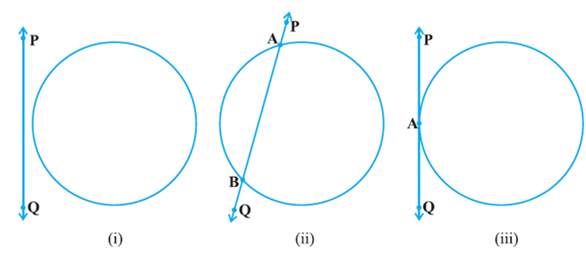
In Fig. (i), the line PQ and the circle have no common point. In this case, PQ is called a non-intersecting line with respect to the circle. In Fig.(ii), there are two common points A and B that the line PQ and the circle have. In this case, we call the line PQ a secant of the circle. In Fig.(iii), there is only one point A which is common to the line PQ and the circle. In this case, the line is called a tangent to the circle.
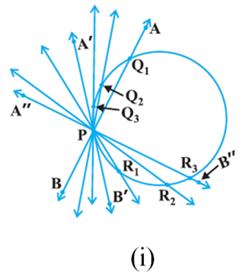
In various positions, the wire intersects the circular wire at P and at another point Q1 or Q2 or Q3, etc. In one position, you will see that it will intersect the circle at the point P only (see position A′B′ of AB). This shows that a tangent exists at the point P of the circle. On rotating further, you can observe that in all other positions of AB, it will intersect the circle at P and at another point, say R1 or R2 or R3, etc. So, you can observe that there is only one tangent at a point of the circle. While doing activity above, you must have observed that as the position AB moves towards the position A′ B′, the common point, say Q1, of the line AB and the circle gradually comes nearer and nearer to the common point P. Ultimately, it coincides with the point P in the position A′B′ of A′′B′′. Again note, what happens if ‘AB’ is rotated rightwards about P? The common point R3 gradually comes nearer and nearer to P and ultimately coincides with P. So, what we see is:
The tangent to a circle is a special case of the secant, when the two end points of its corresponding chord coincide.
Activity 2: On a paper, draw a circle and a secant PQ of the circle. Draw various lines parallel to the secant on both sides of it. You will find that after some steps, the length of the chord cut by the lines will gradually decrease, i.e., the two points of intersection of the line and the circle are coming closer and closer [see Fig (ii)]. In one case, it becomes zero on one side of the secant and in another case, it becomes zero on the other side of the secant. See the positions P′Q′ and P′′Q′′ of the secant in Fig (ii). These are the tangents to the circle parallel to the given secant PQ. This also helps you to see that there cannot be more than two tangents parallel to a given secant.
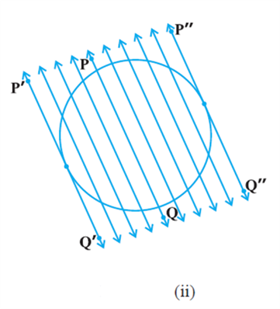
This activity also establishes, what you must have observed, while doing Activity 1, namely, a tangent is the secant when both of the end points of the corresponding chord coincide.
The common point of the tangent and the circle is called the point of contact [the point A in Fig (iii)] and the tangent is said to touch the circle at the common point.
Number of Tangents from a Point on a Circle
To get an idea of the number of tangents from a point on a circle, let us perform the following activity:
Activity 3: Draw a circle on a paper. Take a point P inside it. Can you draw a tangent to the circle through this point? You will find that all the lines through this point intersect the circle in two points. So, it is not possible to draw any tangent to a circle through a point inside it [see Fig (i)].
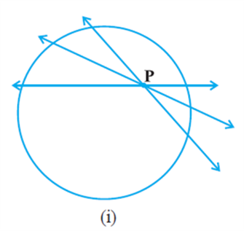
Next take a point P on the circle and draw tangents through this point. You have already observed that there is only one tangent to the circle at such a point [see Fig (ii)].
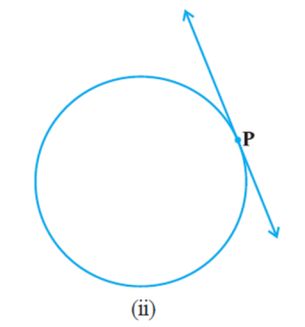
Finally, take a point P outside the circle and try to draw tangents to the circle from this point. What do you observe? You will find that you can draw exactly two tangents to the circle through this point [see Fig (iii)].
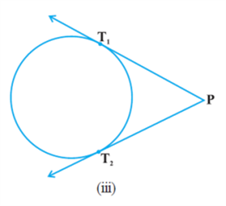
We can summaries these facts as follows:
Case 1: There is no tangent to a circle passing through a point lying inside the circle.
Case 2: There is one and only one tangent to a circle passing through a point lying on the circle.
Case 3: There are exactly two tangents to a circle through a point lying outside the circle. In Fig (iii), T1and T2 are the points of contact of the tangents PT1 and PT2 respectively. he length of the segment of the tangent from the external point P and the point of contact with the circle is called the length of the tangent from the point P to the circle.

 Kaysons Publication
Kaysons Publication
